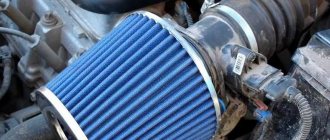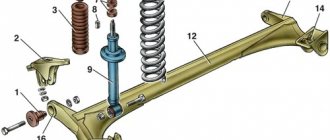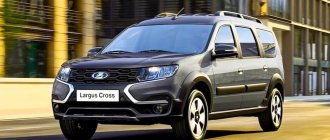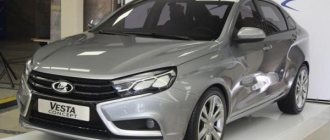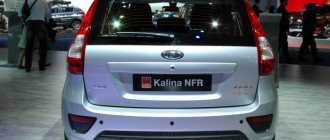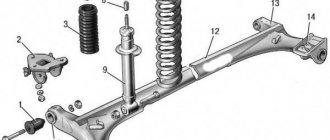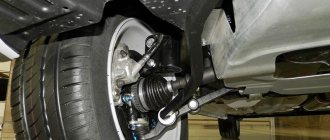When you first get behind the wheel of a Lada Kalina Cross station wagon or in any other body, you immediately understand that the driver is not just an ordinary passenger car, capable of confidently plowing public roads, which makes it stand out from some other cars. This modification is positioned as a car that can overcome light off-road conditions. Does the “cross” version really have a number of significant advantages over the regular Kalina? What is better, if you judge without bias, Kalina or Kalina Cross? How does one model differ from another? Experts tried to present their competent answers to this exciting question.
WHAT ARE WE DOING
A year and a half ago, one of the first commercial Kalina of the second generation appeared in the editorial office. The VAZ-21927 index means, among other things, a new 1.6-liter 106-horsepower engine with an adjustable intake tract length. The car weighs a little more than a ton, many of the tuning company’s solutions were worked out on co-platform Ladas - and we decided to prepare the car for participation in amateur racing.
The RHHCC (Russian Hot Hatch Club Championship) is the country's most popular multi-stage competition, where drivers race around professional circuits in pursuit of the best lap times. There is no contact fighting: whoever covered the track faster wins (Time Attack format). Of the eight classes, our Kalina falls into City-Light with a power ceiling of 150 hp.
Specifications
The first place to start comparing two cars is, of course, the main technical characteristics. In this regard, Lada Kalina 2 and Kalina Cross are very similar in some aspects of consideration.
The engines, components and their gearboxes are approximately the same, the differences here are not significant:
- Kalina 2: VAZ-11186 (87 hp, 8-valve, 1.6 l) is equipped with only manual transmission 5; VAZ-21126 (98 hp, 16-valve, 1.6 l) and VAZ-21127 (106 hp, 16-valve, 1.6 l) are equipped with both manual transmission-5 and automatic transmission-4 (optional).
- Kalina Cross: VAZ-11186 (87 hp, 8-valve, 1.6 l) is equipped with only manual transmission 5; VAZ-21127 (106 hp, 16-valve, 1.6 l) is equipped with both manual transmission-5 and manual transmission-5 (works) - also to choose from.
As a result, consumption, maximum speed and acceleration to 100 km/h are approximately equal; the Cross may have a slight advantage of a slight 0.1-0.3 seconds. Data characteristics:
- acceleration to “hundreds”: 11.2-13.7 seconds;
- consumption per 100 km: combined cycle - 6.7-7.7 liters;
- maximum speed: 167-177 km/h.
Both cars fully comply with EURO-4 environmental standards.
However, significant changes to the Kalina Cross from the “station wagon” lie in a heavily rebuilt suspension/transmission, for example:
- strengthened anti-roll bars;
- the gear ratio of the main transmission pair has been increased (from 3.7 for the station wagon to 3.9 for the Cross);
- increased ground clearance;
- shock absorbers were modernized;
- Many suspension components have been strengthened, for example, the rear beam.
In other nodes, the two models are completely identical and have no differences.
TECHNOLOGY SYSTEM
The SS20 brand, under which the Samara NPP Sistema Technologies produces chassis elements, is known to everyone who is interested in the development of VAZ cars. Supports, shock absorbers, springs, stabilizers, joints, steering mechanisms - Samarans have been developing and producing all this for a decade and a half. But, having learned the conditions of our test, the guys became worried: their products of the most uncompromising “Sport” series promise the opportunity to “enjoy the excitement of sports, feel the adrenaline rush from the emotions received and the pleasure of dynamism, sharp control, a more complete sense of the road...”, and in our test It's not the feeling that's going to matter, it's the lap time!
With our help, the company’s engineers obtained a real Kalina ring strut of the “National” class, took the characteristics at their own stand and assembled an original shock absorber based on racing motives. Based on our experience, they selected a spring for him and brought this set to the Smolensk Ring. Yes, not alone, but together with serial products from the “Sport” line.
Unfortunately, the Samara engineers got it wrong with the springs. In ring cars, the rigidity is higher, and the balance of the rigidity of the front and rear parts is different. As a result, the gain on the experimental racks turned out to be disproportionate - only about a second per lap. Even with the serial “Sport” kit we managed to show better results: minus one and a half seconds. But this achievement is not impressive either. This means you need to play with the springs and, perhaps, reduce the ground clearance even more. The Samarans promised to modify the kit to suit our tasks, so we will repeat the experiment in the spring.
Front pillar elements
On the Lada Kalina car, the struts can be equipped with conical or barrel springs. It all depends on what equipment the car has. The lower coil of the spring rests against the support cup, which is tightly welded to the rack. The upper coil rests on the cup, which is attached to the shock absorber rod.
The rod is secured to the upper support bearing, which, in turn, is screwed to the body using three studs. Thanks to the bearing, the shock absorber rod rotates inside the support. This allows the wheels of the car to turn. A boot must be installed on the shock absorber rod, which protects the inner surface of the element from contamination.
000–108
Since Sistema Technologies produces suspension components, we decided to try something out on our Kalina. We installed stabilizer bars, original upper mounts and camber plates on the rear axle, increasing the angle to two and a half degrees. There was a mistake with the spacers that widened the track - they did not fit tightly to the hub, and we settled on Proma spacers. This set of measures changed the behavior of the car at the level of nuances and allowed us to remove a couple more tenths of a second from the lap, but again there was no breakthrough.
Dimensions and exterior
Important parameters in comparing two cars are size and appearance. It is impossible to single out something in them and say that this is the only correct conclusion, since different people have individual opinions on this matter: some need a larger car, some need a smaller one, not to mention the exterior. However, it would be useful to present these characteristics.
So, the dimensions of Kalina 2 and Kalina Cross are as follows:
- length: 4084 and 4104 mm;
- width: 1700 and 1700 mm;
- height: 1504 and 1560 mm;
- wheelbase: 2476 and 2476;
- ground clearance: 185 and 208 mm;
- weight: 1075-1160 and 1125-1160 kg.
There is no need to be an expert here - Cross is slightly larger than his “comrade”. The main thing worth highlighting here is the ground clearance, increased by as much as 23 mm. Kalina Cross will be a clear leader in cross-country ability, which will be discussed below.
RUSSIAN SHOCK ABSORBERS
Developments in St. Petersburg are led by Vladimir Olenikov, who previously headed the engineering department of the famous Plaza. Products appear in stores under the Damp brand, and among these shock absorbers there are interesting specimens. How do you like, for example, struts lowered by 50 mm while maintaining suspension travel? Or shock absorbers with rebound stiffness adjustment? We received both sets for testing.
Here the effect is clearer. The struts with adjustable rebound force really change the character of the Kalina both on regular roads (if the asphalt is uneven, it’s better to “unwind” them) and on the track. Lap times are comparable to those shown on the best SS20 kit, but the ride quality remains at an acceptable level.
Interior
The design of the cars inside, despite their general similarity, is certainly the most “copied” aspect of all Kalinas. The main differences between the Cross and the “station wagon” are such features as:
- completely redesigned seats, more sporty in nature (many note that they are also more comfortable);
- in some places, the reinforced design of the fastenings of the entire upholstery (for example, on the arches);
- in cars of bright orange color there are inserts of the same color on seats, doors, etc., in more restrained colors the bright inserts are replaced with gray ones.
The remaining elements of the interior are completely similar; you will not find any innovations, except for the branded inserts of the “Cross” name.
The trunk volume has not changed - 355-361 liters in the stock position and 670 with the seats folded. By the way, the tank capacity also remained the same – 50 liters. The decoration is made of standard materials for VAZ: plastic and fabric.
Despite the fact that the Cross has been slightly reworked in the interior, the interior is almost the same. So in this aspect, choosing between cars is pointless.
000–109
And the second set, with a more significant reduction in ground clearance, allowed not only to improve the result by two seconds compared to the serial struts, but also endowed the car with new qualities. Handling has become a little less interesting: if the Kalina with the standard suspension willingly turns when releasing the gas, then with the St. Petersburg shock absorbers the steering has become slightly understeer. But the potential of tires on this suspension is realized better: the low ground clearance made it possible to set a different camber angle of the front wheels (-2º), and when cornering the inner wheel hardly slips! Reactions have also become more accurate: while previously you had to set the trajectory in advance, with Damp struts the car follows the wheel almost instantly. Not a bad budget option.
Reviews about the Cross car
- “Orange notes” only “cheapen” the salon space instead of refreshing it.
- There is enough engine power, and the “M” gear has proven itself well on bumpy road sections.
- Comfortable seats, although lacking lumbar support. This point can be corrected by purchasing anatomical covers.
- Lack of dynamic capabilities, which does not allow long overtaking on the track.
- The climate control is well set up, although it will take a little “practice” to set the optimal temperature.
- There is no anti-fog optics, which is especially negative in bad weather.
- Very thin windshield. A couple of small stones are enough to form a crack.
- After 7 thousand km there were no malfunctions. Satisfied! When choosing between Kalina 2 or Kalina Cross, I preferred Cross.
AST SUSPENSION
The Dutch company AST Suspension has been designing and producing suspension components and kits for 35 years; The range has different lines - for ordinary roads and for sports. In Russia, the sale of its products is carried out by the company, which is headed by former rally driver Alexey Kovalchuk. It’s nice that the Dutch are upgrading their kits taking into account operating experience in our conditions.
It was possible to choose the extreme 5200 model - with remote reservoirs and various adjustments, but, firstly, such a design is not allowed by the RHHCC regulations, and secondly, the price of such a kit is a third of the cost of Kalina. Non-professional athletes have no use for this.
Now opinions about the ordinary Kalina
- Good fuel efficiency, if you compare: in the city no more than 7 liters, and on the highway you can “keep within” 5 liters.
- The car is suitable for repair in non-specialized service stations. No matter what breaks, spare parts will be found immediately.
- The station wagon moved to Kalina from Lanos. The interior of the car from AvtoVAZ turned out to be warmer and warms up faster in winter.
- The suspension is noisy, which is especially noticeable on a textured surface.
- There is enough space in the cabin, although looking at the body from the outside you wouldn’t say so.
- The finishing of the panels in the interior is characterized by cheap plastic.
- Maneuverable car. Among the shortcomings of the interior is poor ventilation of the front windows.
- If the car is loaded, then when driving uphill in 4th gear there is not enough engine torque.
- I have ridden 50 thousand km without any complaints. Now the interior is beginning to manifest itself with squeaks and other unpleasant noises.
So between Kalina 2 or Kalina Cross, I would choose the first option.
Equipment
Good equipment is the first advantage that can be highlighted when reading reviews from owners of the Lada-Kalina station wagon.
The model was offered in three trim levels. The standard included steel wheels, halogen headlights, glazing with ultraviolet protection, bumpers painted in body color, an adjustable steering column, and central locking with remote control.
But that is not all. Also included in the list of basic equipment are front electric windows, door stiffeners, audio preparation, an immobilizer, an alarm system, a driver's kit (jack, wheel wrench, spare wheel), a notification about the need for diagnostics, and also a buzzer for an ignition key left, lights on, rear untranslated transfers.
The next configuration was called “norm”. The car in this version, in addition to the above, also had a mirror in the passenger sun visor, decorative wheel covers, climate control, an audio system (FM CD MP3) with two speakers and an antenna.
In the luxury version, the car was additionally equipped with rain sensors, a curtain in the luggage compartment, an ABS system, a seat belt tensioner, driver and front passenger airbags, rear electric windows, heated seats and mirrors (with electric drive), and also fog lights. By the way, the wheels on the version with this configuration were fitted with light alloy wheels.
Considering all of the above, one can understand why the majority purchased the Kalina in a luxury version. The price difference at that time was approximately 70,000 rubles for a model with an 81-horsepower 1.6-liter engine.
Off-road test
As practice shows, off-road is a serious test for both the Lada Kalina Cross and the Lada Largus Cross. Mud obstacles also pose a serious problem for these cars. This is partly due to the fact that Kalina Cross and Largus Cross are station wagons and their ground clearance is raised slightly. But they also worked on the chassis of the cars and seriously changed their geometry, due to which both models acquired a more massive wheelbase. The ground clearance of the Lada Largus Cross is 21 cm, while the ground clearance of the Lada Kalina Cross is 18 cm. In principle, these dimensions are quite enough for a comfortable ride.
Known modifications
Since the first serial production of Chevrolet, VAZ 2131 cars have undergone several improvements. Each modification has its own buyer. There are 4 modifications of the Chevrolet, some of which have already been discontinued, but have not lost demand.
The first in the line is the VAZ 2131 of the old modification, in which the changes affected only the appearance and interior decoration. Imported power steering, fog lights were added, seat heating for the driver and front passenger was adjusted, and air conditioning was added. There were 4 configurations of this modification, the differences between which were in the equipment and, accordingly, the price. The old modification of the VAZ 2131 was produced from 2004 to 2006. It consisted of 98% Russian-made components.
Chevrolet Niva FAM 1 - 125 hp
Since 2006, the joint venture GM AvtoVAZ has released a new modification of the Chevrolet Niva FAM 1, better equipped in terms of technical characteristics: an OPEL engine and a 5-speed gearbox. For the first time, ABS was included in the Lada's package; it began to comply with Euro 3 and Euro 4. However, this modification was not produced for long, since it did not gain recognition among domestic car enthusiasts.
Since 2009, a new model of Lada has been put into production. This modification has received wide recognition and is currently available in 6 trim levels: L, LC, LE, GLC, GLS, LE+. Since 2015, all Lada cars of this modification are equipped with engines in accordance with Euro 5 requirements. Chevrolets of the new model correspond to the basic configuration of the VAZ 2131. The difference in modifications is only a difference in tuning equipment and appearance.
Especially for lovers of active recreation, a modification of the Chevrolet Trophy was released for off-road use. This car is better equipped. The technical characteristics of the car are designed taking into account extreme natural conditions. Especially for the Trophy configuration, the chain tensioner, the mechanism for attaching the electric winch were improved, and a snorkel was installed.
But car enthusiasts expect the main highlight of the new generation of Lada cars next year. As you know, the AvtoVAZ concern has planned the release of a new Chevrolet configuration. The release of the second generation Chevrolet was planned for 2022, but due to current circumstances it was postponed to 2022. Car enthusiasts are eagerly awaiting the appearance of the updated 2022 Chevrolet. The appearance of the Chevrolet Niva 2 is an evolutionary step for AvtoVAZ. The new model is being developed jointly with Porsche. It is already known that a Peugeot Citroen engine will be installed on it, the power frame and gearbox will be completely changed. The second generation Lada 4x4 will also undergo significant changes.
Is it worth paying extra?
Most car enthusiasts have a certain stereotype that the more a car costs, the better it is. A Lada Largus Cross with a 105 horsepower engine and a manual transmission will cost the buyer 669 thousand rubles. If you need a seven-seat version of the Lada Largus Cross, you will have to pay 30 thousand rubles more. And here the question arises, is this a lot or a little, given that the crossover has quite good demand? After all, buyers even line up to become the owner of this car. And here the Lada Kalina Cross will look much more profitable, because The cost of this car is 495,800 rubles. And if, in addition, you purchase a robotic version of the transmission and a more powerful engine, you will have to pay an additional 20 thousand rubles.
Salon Largus Cross
How to replace longitudinal tension
In order to adjust the longitudinal tilt angle of the axle, you must contact a service center. At the same time, they will definitely remove the stretch. Therefore, you should not change it yourself; it is better to do this immediately before adjustment. But, if you remove the old stretcher and install it in place, in order to minimize the error in adjusting the caster angles of the axle, you need to count and record the number of washers that were located on the rear and front edges of the stretcher before removal.
The replacement procedure is as follows:
- Remove the bracket that secures the suspension extension.
- Use a 24mm wrench to keep the extension from turning. And with the second key you need to unscrew the nut that secures the front end to the wishbone.
- Remove the washer from the brace and remove the rear edge from the hinge.
- Remove the adjustment washers completely.
Installation of the longitudinal extension is performed in exactly the reverse order. It is necessary that the chamfers on the adjusting washers face the extension. After replacement, it is necessary to adjust the wheel alignment angles. This is a mandatory condition if the Kalina suspension is being repaired.
Troubleshooting
As mentioned above, malfunctioning struts are a common problem, especially for novice drivers. Immediately after detecting the primary symptoms of a breakdown, it is recommended to replace the part with a similar one.
The most noticeable “symptom” is oil leakage. Oily spots may appear under the car. If everything is in order with other elements, it is worth replacing the racks. Make sure there is no external damage: any cracks or chips.
If the car body sways strongly when driving, it does not stay in the rut and “wobbles,” which means that the stabilizer is not working correctly. This can lead to you flying into the oncoming lane or falling into a ditch if you often drive on intercity highways.
Note that the stabilizer strut is a consumable part, which is useless to repair. The most rational solution is to purchase a new spare part and install it instead of the faulty one. Moreover, now you can choose almost any part, the main thing is that it matches the dimensions of the car. Let's consider several replacement options.
